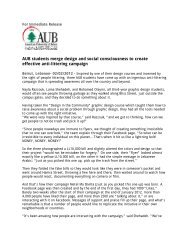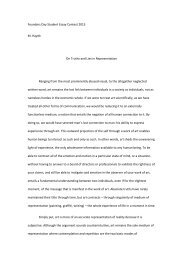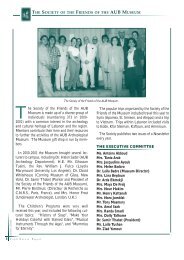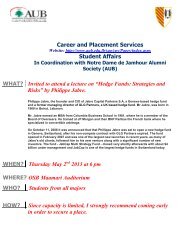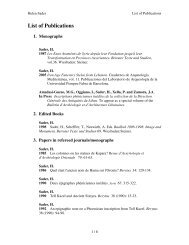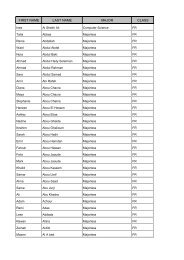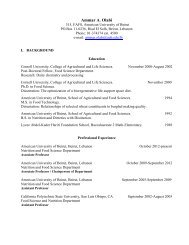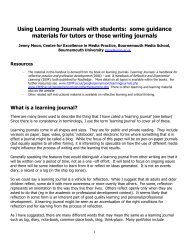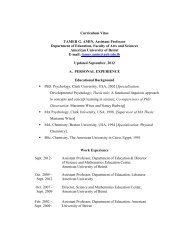The IX t h Makassed Medical Congress - American University of Beirut
The IX t h Makassed Medical Congress - American University of Beirut
The IX t h Makassed Medical Congress - American University of Beirut
Create successful ePaper yourself
Turn your PDF publications into a flip-book with our unique Google optimized e-Paper software.
T h e I X t h M a k a s e d M e d i c a l C o n g r e s s<br />
and weaning <strong>of</strong>f invasive ventilation, but there was only weak support for NIV in others, such as<br />
immunocompromised patients. For other groups, such as patients with asthma, pneumonia, or<br />
acute lung injury, RCT-level evidence was lacking or did not suggest benefit (6-8). More recently,<br />
53 adult patients with severe acute asthma (FEV1 < 30% <strong>of</strong> predicted) were randomized to NIV<br />
(n=28) or standard medical therapy (n=25). ICU and hospital stay was significantly shorter and<br />
the mean dose <strong>of</strong> inhaled bronchodilator was significantly less in the NIV group. <strong>The</strong> four patients<br />
with standard-medical-therapy failure improved with NIV. Two patients in the NIV arm required<br />
invasive ventilation. <strong>The</strong>re was no mortality in either <strong>of</strong> the arms. <strong>The</strong> authors concluded that a<br />
larger study is required (9).<br />
For children, there is little evidence from randomised controlled trials that early intervention with<br />
NIV reduces mortality; however, a number <strong>of</strong> reports suggest that NIV is useful in ARF by avoiding<br />
the need for intubation (10). In the prospective series by Yanez et al, comparing 25 children NIV plus<br />
standard therapy (n=25) with standard therapy (n=25), diagnoses were moderate asthma (n=5),<br />
viral bronchiolitis-pneumonia (n=42), bacterial peumonia (n=3). Tracheal intubation was lower in<br />
the NIV group (28%/60%; p=0.045) (4). In another series, 20 children (mean age 48 months) with<br />
lower airway obstruction were randomized to receive alternatively 2 hours <strong>of</strong> nasal NIV, followed<br />
by crossover to 2 hours <strong>of</strong> standard medical treatment. Compared to the baseline values, NIV<br />
was associated with lower respiratory rate, total Clinical Asthma Score, and delivered oxygen<br />
concentration needed to maintain oxygen saturation ≥ 90% (all p < .01) (11). Viral bronchiolitispneumonia,<br />
mainly due to RSV, represents the largest cohort <strong>of</strong> children treated with NIV (2, 4,<br />
12-16). In all reported series (none <strong>of</strong> them was randomized and prospective), a decrease in<br />
respiratory rate and pCO 2 level was usually observed within 1 or 2 hours, and 75-80% <strong>of</strong> infants did<br />
not need intubation (15). Clinical conditions with ARF where NIV is used are summarized in table<br />
2 (10). Finally, NIV may also be palliative.<br />
Do we have predictive factors <strong>of</strong> NIV failure in children with acute respiratory failure?<br />
In children with severe exhaustion from respiratory failure or reduced conscious level, there are<br />
risks from treatment with NIV without an adequately secured airway, including gastric distension<br />
and aspiration. NIV does not protect the airway or allow as effective clearance <strong>of</strong> lower airway<br />
secretions as does intubation, particularly in the child with a reduced conscious level. However,<br />
effective airway clearance is helped by any ventilation that allows maintenance <strong>of</strong> good lung<br />
volumes from which a more effective cough may be generated.<br />
<strong>The</strong> best predictive factors for the success <strong>of</strong> NIV in acute respiratory failure appear to be the<br />
respiratory rate and the level <strong>of</strong> inspired oxygen 1 or 2 hours after starting NIV. Lack <strong>of</strong> effectiveness<br />
arises mainly from agitation, poor airway protection or abdominal distension. Several authors<br />
have identified different predictive factors <strong>of</strong> NIV failure in the PICU: the results <strong>of</strong> studies, which<br />
regard children with ARF <strong>of</strong> different causes, are given in table 3. Other studies have focused on<br />
only one disease such as bronchiolitis in infants (12-15). In conclusion, NIV is a treatment option<br />
available for children experiencing acute respiratory failure. NIV needs an experienced staff and<br />
is not appropriate for children who are unable to protect their own airway, severely exhausted<br />
or have a reduced level <strong>of</strong> consciousness. <strong>The</strong> selection <strong>of</strong> the NIV interface is essential in order<br />
to achieve the most successful outcome (17). Clinical assessment with continuous monitoring <strong>of</strong><br />
SpO 2 and if possible PtcCO 2 must be rigorous in order to identify patients not responding to NIV<br />
and needing intubation.<br />
60





